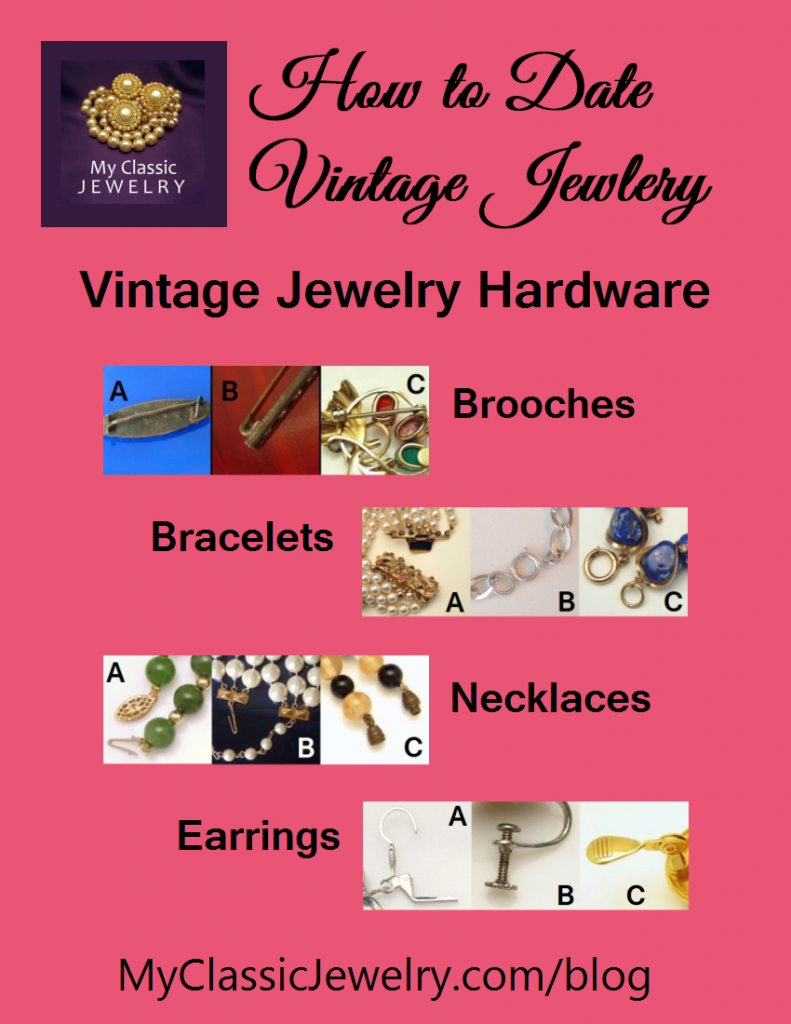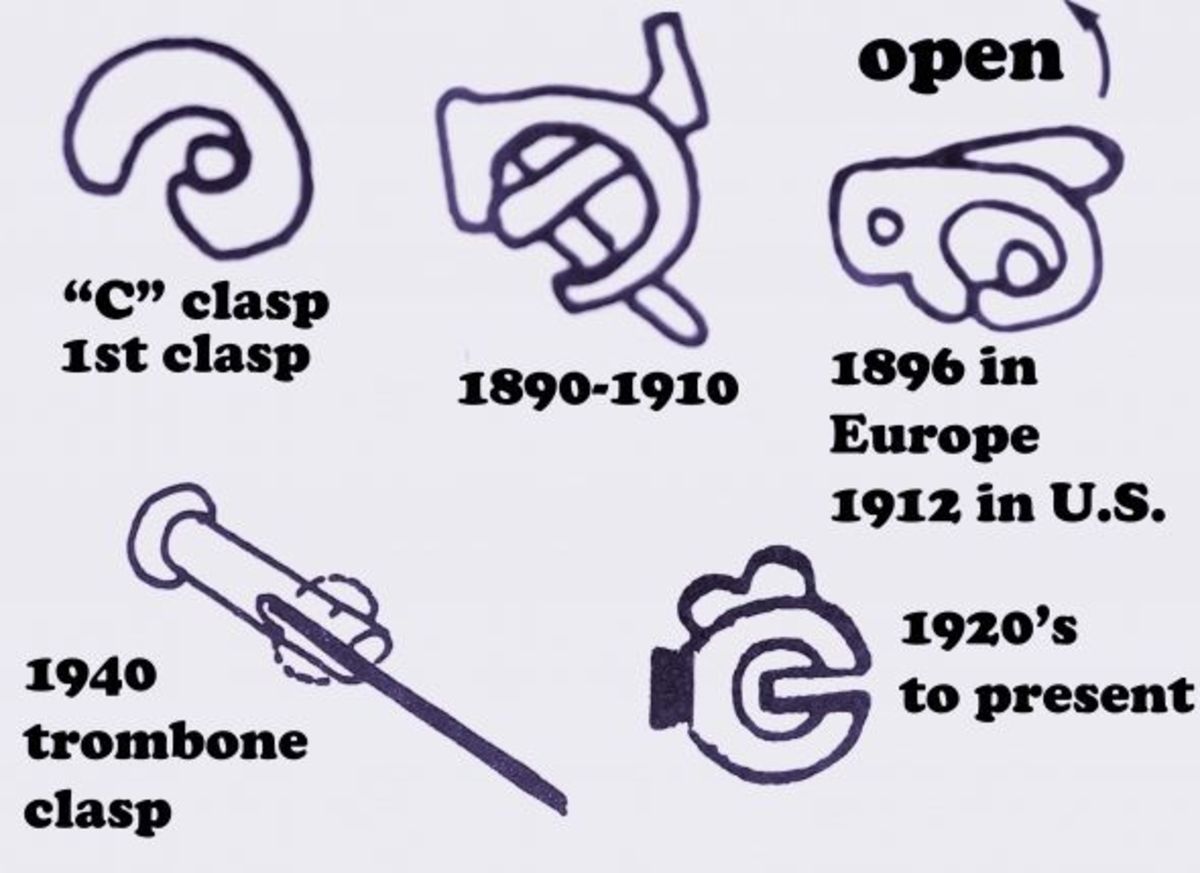- The Jewellery Muse
- Dating vintage jewelry clasps
- Clue 1: Fittings and Findings for Earrings
- Dating vintage jewelry clasps - Murmuration
Note that the long pin was still popular. The trombone tube clasp never really became that commonly used, and was generally seen on brooches from around the s up to the s. It consists of a cylinder tube within a cylinder — you pull the inner cylinder out to release the pin. A standard roll-over pin and clasp, as seen on this vintage crude shell cameo, Roll overs generally became the most popular brooch fitting from around the s onward to today.
Note how short the pin itself has become, especially when compared to the long Victorian pins. A good close up of a roll over clasp. Just to confuse things, this is actually a repair job — a more modern clasp has been soldered onto a much older antique Victorian mourning brooch. Dating old jewellery can be complicated! Go to auctions, antique fairs and proper vintage shops and have a really good look at what genuine vintage jewellery looks and feel like.
And remember — as pointed out previously, these are general guidelines only — you may find c-clasps on modern brooches, and early types of rollovers on pres jewellery. You are commenting using your WordPress. You are commenting using your Twitter account. You are commenting using your Facebook account. Notify me of new comments via email. The clasps used on bracelets depend on the type of bracelet. Wide bangles typically used secure hinges with tongue and groove type clasps also known as box clasps , while more delicate link bracelets used ring clasps.
Wider link bracelets set with stones would often have fancy decorated box clasps. The lobster claw clasp in use today is a fairly new design from the late s, as is the toggle clasp. The spring ring clasp, introduced in the early 20th century, is the most common vintage bracelet clasp. It has a spring inside the ring that allows it to open and snap closed.
A variation of this is the sport ring clap, which works the same way, but instead of a nub, it has a ridged end used to open the ring. Foldover clasps were used on both bracelets and necklaces. These could be either narrow or wide, depending on the width of the pieces. Pieces with stones would sometimes have foldover clasps that were decorated with matching stones.
The sister hook clasp was popular in the s and s.
It had two scissor-like hooks that opened in the middle, then overlapped each other when closed. Early designs were rectangular in shape. Monet had a patented, rounded sister clasp used in its jewelry in the s and s. In addition, there were some specialty clasps used, such as snap clasps, unique pin clasps found on wide link and bangle bracelets, and unique hook clasps.
The Jewellery Muse
As with bracelets, commonly used vintage necklace clasps include ring clasps, foldover clasps, and box clasps. Often oval shaped, the long hook was inserted and locked into place. Usually, the necklace had a chain that allowed the hook to use any of the chain links, making the necklace length adjustable. The S-hook clasp is a variation on the hook, with a rounded, S shape. Older pieces will show some darkening of the metal, looking more like brass.
In the kidney wire was introduced. This was a more sturdy and secure fastener, as the wire was secured with a hook at the bottom of the earring. Both fish hooks and kidney wire earring backs are still in use today. Post earrings also known as stud earrings were also common at this time and normally the studs were threaded so that the backs of the earrings could be secured with screws. Up until the s all earrings were made for pierced ears. In the screw-back earring was invented, allowing women without pierced ears to wear earrings.
The earring clip was patented in and by the s became the preferred earring style for women without pierced ears.
The clip mechanism has been improved over time and clip earrings are still quite popular today. You can view it here: There are additional attributes that help to identify and date pieces. Other jewelry parts such as the metal, plating, stones, and bead characteristics can help determine the origin and age of jewelry. These are additional topics that I plan to write about in the future. I hope this article has been helpful to you. Please click the comments link below this article to add your comments.
To share this article, use the share buttons below. You can also use the Social Media buttons in the right sidebar to visit my pages.
Christine, I was impressed with the information you provided. It is simaler to an oval shape. Split at top section of oval. The strange part is one side front hook is straight.
Dating vintage jewelry clasps
The back half of clasp, how I see a tpye of safety latch. Anyway I would like to know and learn more about jewelry. You have peaked my interest more than before reading your article. I sometimes ramble and get lost in the thinking of it. Anyway these earring clasps are different. The back piece has an opening for the front piece to go in thus securing it better. I was wonder wher I could find pictures of all different styles. Thank you for letting me ramble on, too.
Clue 1: Fittings and Findings for Earrings
This is such great information. Thank you for taking the time to write it. I am bookmarking it for future reference. One piece, in particular, is a very large copper Indian vintage necklace that I need to find the value of. She also has several Ivory necklaces and some scrimshaw bracelets and ring, a star ruby and diamond ring, that dates back to the early s, which has a very unusual shape and other valuable pieces.
Where do I go to a reputable place who will give me an idea of what these pieces are worth. Any info you can provide me would be greatly appreciated. The colors of the star are in the correct order, however, it is not facing the correct direction. The white ray should be pointing down.
This also suggests that it is not original as an Eastern Star member would know the correct way it is worn. The colors on the star are incorrect but I don't know if it is just the way it photographed. The star should be blue, yellow, white, green, and red. I'm in the process of sorting out my jewellery that I have inherited from my two grandmas and my mum. Your website is proving to be very helpful.

To give you an idea of time both my Grandmas were born in the late s and died during the s so your article is so helpful. However are three items in my collection that I have no idea about.
Dating vintage jewelry clasps - Murmuration
They are threaded on a piece of string. They feel like they are made of hardened glass or ceramic. However, they are covered with the most intricate beautiful minute coloured flower patterns on both sides, around the edges and even into the holes at both ends of each one. All patterns are different on each of these 'pendants' in blues, yellows, white, green and russett red. They look quite amazing and don't deserve to be tied together on a piece of string.
